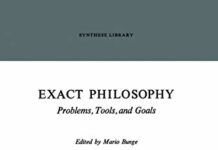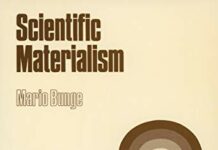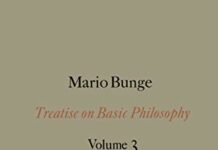
Ebook Info
- Published: 2011
- Number of pages: 212 pages
- Format: PDF
- File Size: 5.15 MB
- Authors: M. Bunge
Description
User’s Reviews
Reviews from Amazon users which were colected at the time this book was published on the website:
⭐Although I hardly have an adequate background to digest the full scope of this book, I nonetheless found Professor Bunge’s writing to be generally quite clear, very informative, and eminently readable. I especially liked its methodical organization, incisive characterizations, and succinct in-line clarifications/examples. Together with summary tables, his symbolic notations and enumerated statement indices were great aids to concision and understandability. More graphical taxonomies would have been similarly helpful, for the few figures used were decidedly beneficial for clarity’s sake. In a negative vein, however, the author’s occasional imperious pronouncements were off-putting as well as largely unsupported.Aside from a substantial and valuable introduction, the book has three parts: Scientific Method; Conceptual Models; and Metaphysics. Each contains three essays, all of which had been previously published. Remarkably, the flow of the various ideas throughout the book is rather smooth among the different essay topics. Moreover, there is some reassuring reinforcement among certain of the essays despite their disparate subjects/origins. The book was published over forty years ago, so the current status of the ideas presented, even on the author’s part, is unknown to me. Nevertheless, the ideas presented were for the most part plausible, well articulated, and interesting to me.Elsewhere, Professor Bunge has stated that “Exactness is not just fastidiousness but a component of clear thinking, a condition for theorizing.” Notably, this book very substantially explicates, exemplifies, and fosters that virtue, especially in the context of scientific research. Early on in the book, the nature and benefits of an axiomatic approach to science are described. Then, in the last chapter, this approach can serve as the core resource to enable the author’s critical realism methodology as outlined there. Chapters in between examine and characterize key facets of such methods and associated guidelines for composing sound, exacting, and defensible scientific theories. In retrospect at least, these intervening chapters fit together well in fostering and undergirding superior, well formed theories.Each of these chapters holds appeal on its own, subject to the reader’s particular interests. For example, the chapters addressing models, analogies, and level structures were of especial interest to me. Models in the first case referred to model objects, which serve as initial conceptualizations of research strategies. Each constitutes a cogent ideational nucleus or kernel – one that can potentially evolve into a scientific theory. In particular, a model object captures predicates ascribed to equivalence classes of elements of a corresponding represented object. Analogies are developed in terms of the degree of similarity within related technical formalisms, with the following progression of increasing conformity among such elements: analogy, simulation, representation. Moreover, this progression ties back to the notion of a model object, and its evolution into a particular characterization of a represented object. Desirably, a resultant theory very closely coincides with the reality of the represented object. Next, the level structure can be used systematically to assemble relevant scientific facts bottom-up in proximately interrelated tiers. Ascending levels of the structure correspond to an increasingly larger scale of factual elements, all of which on any given level share certain distinguishing properties. Upon completion, a particular level structure may constitute the essence a credible scientific theory.Regarding dogmatic assertions that lack support herein, biological and sociological statements are two matters of concern. Then, there is the issue of `do as I say, not as I do’ disconnects. Consider the following instances:● “The methodological vitalist…asks us to believe him, not to understand him” (p. 62). Ironically, Professor Bunge seems to do precisely the same thing in a number of cases, with summary doctrinal declarations like ones noted below. Moreover, he has a penchant for unwarranted denigratory labels like `vitalist,’ per his polemical terminology distortions or improvisations. Accordingly, the pervasive tone of the essay on biology methodology is strident, skewed, and off-putting.● Furthermore, “the methodological vitalist claims that life cannot be understood with the HELP (emphasis mine) of the scientific method as practiced in physics and chemistry” (p. 45). N.B.: `with the help of’ and not `with exclusive reliance upon’. I would like to see even one scholarly reference wherein a so-called vitalist makes this claim.● “in science…there is no royal road…However it is useful to know what kind of dirt roads are open to use” (p. 147). But perhaps not, as indicated by statements anathematizing “pronouncements concerning the inherent limitations of mathematical modeling” (p. 59); after all, “the thesis that life is reluctant to mathematization is just dogma” (p. 60). Whoa! Too bad Kurt Godel did not get comparable counseling before pooping the formalists’ party!● But at least the author has identified the cause of intractability regarding biological aspects of life: “traditionally minded biologists should be blamed for the undeveloped state of theoretical (mathematical) biology” (p. 59). But then a major concession: “biology is not deducible from physics and chemistry WITHOUT FURTHER ADO (emphasis mine)” (p. 66). Hey, what are scientists waiting for? – just add a little `ado.’● “mathematical sociology is only starting to move toward its Newtonian synthesis. Once it produces generic theories subsuming large numbers of theoretical models, it should look more glamorous” (p. 142). Of course, the connotation of the Newtonian world view is mechanical or deterministic behavior, which hardly seems ascribable to human beings or their institutions. And how might such behavior be objectively measured in terms of stable, universal, and definitive variables? Furthermore, stochastic effects notwithstanding, the four examples presented in the book are not even remotely commensurate with the espoused socio-Newtonian vision.In all, I nevertheless liked this book. I am not sure though, how current its viewpoints are with respect to Professor Bunge’s later thinking. Hence, I will now read his “Scientific Realism: Selected Essays of Mario Bunge” for an updated calibration. Ultimately though, any interested reader expropriates or adapts a book’s ideas that seem to be personally useful, and there is considerable such value for me in this book. So on balance, I rate this book at Five Stars because of its mainly compelling ideas and formulations. Moreover, I do not know that anyone else has made or even attempted a comparably well formed and well articulated position on the practical yet exacting conduct of scientific research.
⭐
Keywords
Free Download Method, Model and Matter in PDF format
Method, Model and Matter PDF Free Download
Download Method, Model and Matter 2011 PDF Free
Method, Model and Matter 2011 PDF Free Download
Download Method, Model and Matter PDF
Free Download Ebook Method, Model and Matter



